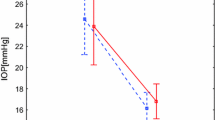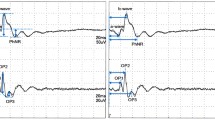Abstract
The hyperosmolarity response of the standing potential was recorded in retinitis pigmentosa (20 eyes), central (pericentral) retinitis pigmentosa (4 eyes), pigmented paravenous retinochoroidal atrophy (2 eyes), fundus albipunctatus (8 eyes), and Stargardt's disease (or fundus flavimaculatus) (14 eyes). The light peak/dark trough ratio (the L/D ratio) and the Diamox response were also determined.
The hyperosmolarity response was greatly suppressed (less than M-4SD; M and SD indicate respectively the mean and the standard deviation in normal control subjects) in all examined eyes with retinitis pigmentosa (20 eyes) including retinitis pigmentosa sine pigmento (8 eyes), central (pericentral) retinitis pigmentosa (4 eyes), and pigmented paravenous retinochoroidal atrophy (2 eyes). The L/D ratio was larger than 1.26 (M-2.5 SD) in the half of the eyes with the above-described diseases.
The hyperosmolarity response was abnormal (less than M-2 SD) in 4 of 8 eyes with fundus albipunctatus. The L/D ratio was normal in all 8 eyes.
The hyperosmolarity response was abnormal (less than M-2 SD) in all 14 eyes with Stargardt's disease or fundus flavimaculatus. The L/D ratio was abnormal in 5 of these 14 eyes.
The hyperosmolarity response was more frequently abnormal than the L/D ratio in the chorioretinal dystrophies mentioned above, and hence is useful particularly for early diagnosis of these disorders.
Similar content being viewed by others
References
Carr RE and Siegel IM (1964) Electrophysiologic aspects of several retinal diseases. Amer J Ophthal 58:95–107
Deutman AF (1977) Rod-cone dystrophy: primary, hereditary, pigmentary retinopathy, retinitis pigmentosa. In: Krill's Hereditary Retinal and Choroidal Diseases, ed.: AE Krill, Vol 2. Hagerstown, Harper & Row, pp 479–576
Kawasaki K, Yamamoto S and Yonemura D (1977) Electrophysiological approach to clinical test for the retinal pigment epithelium. Acta Soc Ophthal Jpn 81:1303–1312
Kawasaki K, Yonemura D, Nakazato H, Wakabayashi K and Yamamoto S (1980) Electroretinographic cone potential in macular dystrophies. Jpn J Clin Ophthal 34:691–698
Klien BA and Krill AE (1976) Fundus flavimaculatus and Stargardt's disease. Amer J Ophthal 82:527–539
Krill AE (1977) Flecked retina diseases. In: Krill's Hereditary Retinal and Choroidal Diseases, ed.: AE Krill, Vol 2. Hagerstrown, Harper & Row, po 739–824
Kubota Y (1970) Studies on ERG and EOG of various congenital night blindness. (3) EOG of fundus albipunctatus and pigmento degeneratio retinae. Acta Soc Ophthal Jpn 74:1479–1483
Madachi-Yamamoto S (1982a) Electrophysiological evaluation of retinal pigment epithelium for clinical use (I) Hyperosmolarity response of the standing potential and its origin. Acta Soc Ophthal Jpn 86:374–384
Madachi-Yamamoto S (1982b) Electrophysiological evaluation of retinal pigment epithelium for clinical use (II) Hyperosmolarity response in normal subjects. Acta Soc Ophthal Jpn 86:385–395
Madachi-Yamamoto S, Yonemura D and Kawasaki K (1984) Hyperosmolarity response of ocular standing potential as a clinical test for retinal pigment epithelium activity. Normative data. Docum Ophthal 57: 153–162
Michaelson IC (1980) Textbook of the Fundus of the Eye, 3rd ed. Edinburgh, Churchill Livingstone, pp 407–422
Miyake Y, Asano T, Sakai T and Watanabe I (1972) ERG and EOG in retinitis punctata albescens. Acta Soc Ophthal Jpn 76:247–256
Mizuno K and Nishida S (1967) Electron microscopic studies on human retinitis pigmentosa. Amer J Ophthal 63:791–803
Noble KG and Carr RE (1979) Stargardt's disease and fundus flavimaculatus. Arch Ophthal 97:1281–1285
Yanoff M and Fine BS (1982) Ocular Pathology, 2nd ed. Hagerstown, Harper and Row, p 540
Yonemura D and Kawasaki K (1979) New approaches to ophthalmic electrodiagnosis by retinal oscillatory potential, drug-induced responses from retinal pigment epithelium and cone potential. Docum Ophthal 48:163–222
Yonemura D, Kawasaki K, Tanabe J and Yamamoto S (1978) Susceptibility of the standing potential of the eye to acetazolamide and its clinical application. Folia Ophthal Jpn 29:408–416
Author information
Authors and Affiliations
Rights and permissions
About this article
Cite this article
Yonemura, D., Kawasaki, K. & Madachi-Yamamoto, S. Hyperosmolarity response of ocular standing potential as a clinical test for retinal pigment epithelium activity chorioretinal dystrophies. Doc Ophthalmol 57, 163–173 (1984). https://doi.org/10.1007/BF00143080
Published:
Issue Date:
DOI: https://doi.org/10.1007/BF00143080
Key words
- retinal pigment epithelium (RPE)
- standing potential
- hyperosmolarity response
- retinitis pigmentosa
- central and pericentral retinitis pigmentosa
- pigmented paravenous retinochoroidal atrophy
- fundus albipunctatus
- Stargardt's disease
- fundus flavimaculatus
- light peak/dark trough (L/D) ratio
- Diamox response
- electro-oculogram(EOG)




